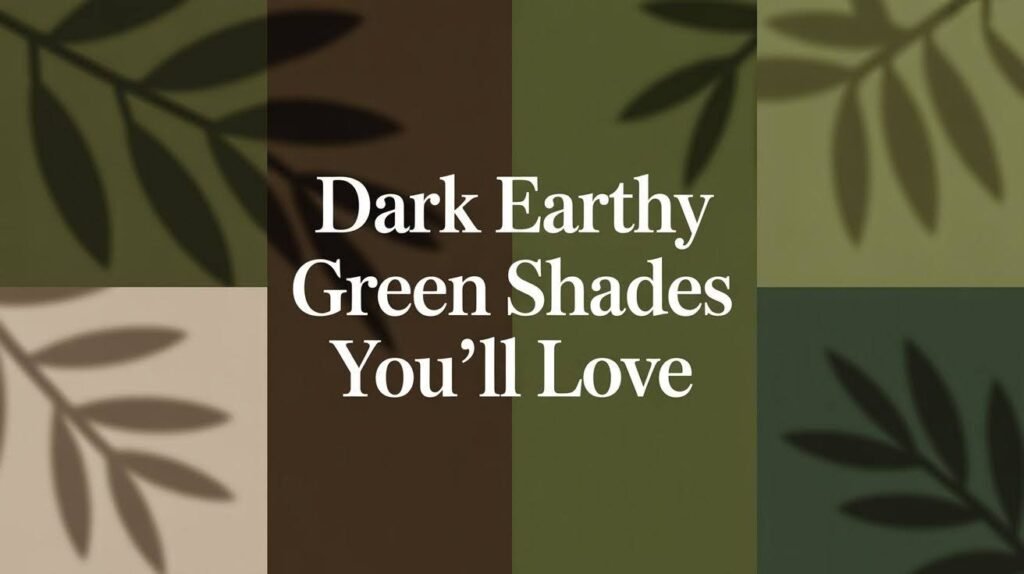Dark earthy green has become a favorite choice in home decor for its ability to create calm, grounding spaces that feel connected to nature.
These rich, muted tones offer sophistication and warmth that brighter greens simply can’t match, while providing more personality than standard neutrals like beige or gray.
Earthy greens work beautifully across various design styles – from modern minimalist spaces where they add organic depth, to rustic farmhouse interiors that benefit from their natural warmth, to organic-inspired rooms that celebrate biophilic design principles.
These versatile shades serve as excellent accent colors or bold statement walls, creating environments that feel both contemporary and timeless while promoting relaxation and well-being in any home setting.
How to Choose the Right Dark Earthy Green
Selecting the perfect dark earthy green depends on your room’s size, lighting, and existing decor. Smaller spaces benefit from lighter earthy tones, while larger rooms can handle deeper, more saturated shades.
Natural light enhances these colors, but rooms with limited sunlight work better with warmer-toned greens.
Understanding undertones is crucial for creating harmony. Warm earthy greens with yellow or brown undertones complement wood furniture and brass accents, while cooler greens with blue or gray undertones pair well with silver hardware and contemporary materials.
Consider your existing color palette to ensure seamless integration. These greens work beautifully with natural materials like wood and stone, neutral colors such as cream and taupe, and metallic accents in gold or copper for a cohesive, sophisticated look.
List of 15 Stunning Dark Earthy Green Paint Colors
Browse rich, refined green paint options from top brands including Benjamin Moore, Sherwin-Williams, and Farrow & Ball for any interior style.
1. Sherwin-Williams Rookwood Dark Green (#355D3D)

This deep, historical green carries a vintage vibe that instantly adds character to any space.
Its rich, saturated tone works beautifully in libraries where it creates a scholarly atmosphere, dining rooms where it promotes intimate conversations, or exteriors where it provides timeless curb appeal.
The color’s complex undertones shift throughout the day, appearing deeper in morning light and more vibrant during golden hour, making it particularly suitable for rooms with varying natural light conditions.
2. Benjamin Moore Salamander (#292E1C)

Nearly black-green with bold character, Salamander makes a dramatic statement without overwhelming a space.
This sophisticated shade is ideal for accent walls that need visual weight and presence, or cabinetry that demands attention while maintaining refinement.
The color’s depth creates an almost chameleon-like quality, appearing different depending on surrounding colors and lighting conditions.
In natural light, subtle green undertones emerge, while artificial lighting brings out its darker, more mysterious qualities.
3. Behr North Woods (#2D3E2A)

Rich forest green with warm undertones that evoke peaceful woodland walks and natural serenity.
This color works beautifully with brass fixtures and natural wood accents, creating spaces that feel both grounded and inviting while maintaining a connection to the outdoors.
The warm undertones prevent the color from feeling cold or stark, making it suitable for living rooms, bedrooms, and dining areas where comfort is paramount and natural materials are featured.
4. Farrow & Ball Green Smoke (#6B7367)

Smoky green with subtle gray undertones that create depth and complexity, offering a sophisticated alternative to standard greens.
Perfect for cozy bedrooms where it promotes restful sleep and relaxation, or reading nooks where it encourages contemplation and quiet moments.
The color’s muted quality makes it less stimulating than brighter greens, creating calm environments conducive to rest.
Its gray undertones allow it to work beautifully with both warm and cool color palettes, making it highly versatile.
5. Valspar Pine Forest (#1A3A1A)

True evergreen feel that brings the outdoors inside with authentic forest vibes and natural appeal.
This shade complements stone fireplaces and natural textures beautifully, creating rooms that feel connected to nature and grounded in organic materials.
The color captures the essence of dense forest canopies, providing a sense of shelter and protection that makes spaces feel secure and comforting.
It works particularly well in rustic or cabin-style interiors but can also add organic warmth to modern spaces.
6. Clare Current Mood (#5D6B4F)

Moody olive green with a modern twist that feels both contemporary and timeless, offering perfect balance between trendy and classic.
Great for feature walls in living spaces where it adds personality without overwhelming the room’s overall aesthetic or competing with furnishings and artwork.
The color’s olive undertones give it warmth and sophistication, while its modern interpretation keeps it from feeling dated.
This shade works beautifully in open-concept spaces where it can define different areas without creating visual barriers.
7. Dunn-Edwards Cypress (#3F4F3F)

Earthy and subdued with grayish undertones that create a calming, sophisticated atmosphere perfect for both interior and exterior applications.
This versatile shade works equally well for exteriors that need subtle elegance and timeless appeal, or peaceful interior spaces where tranquility is desired.
The color’s muted quality makes it less demanding than brighter greens, allowing it to serve as a sophisticated neutral that still provides color interest while working with various design schemes.
8. PPG Night Watch (#2B4D2B)

Lush, luxurious dark green that exudes richness and depth, creating spaces that feel opulent and Refined.
This dramatic color pairs beautifully with gold hardware and jewel-toned accents, creating rooms that feel both elegant and grounded in natural beauty.
The color’s intensity makes it perfect for creating focal points and dramatic statements, while its green base keeps it from feeling too heavy or oppressive in formal dining rooms, master bedrooms, and home libraries.
9. Benjamin Moore Backwoods (#3A5F3A)

Classic dark green with heritage feel that honors traditional design principles and timeless appeal.
Perfect for traditional or farmhouse interiors where it provides authentic, enduring charm that never goes out of style.
This color works beautifully with vintage furniture pieces, natural wood elements, and classic architectural details like crown molding and wainscoting.
Its balanced undertones make it suitable for both formal and casual spaces, creating warmth and sophistication that feels both comfortable and refined.
10. Sherwin-Williams Pewter Green (#4A5D4A)

Muted green-gray with remarkable depth that works in both traditional and contemporary settings with equal effectiveness.
This sophisticated shade looks amazing on kitchen cabinets or trim work where it adds subtle color interest without overwhelming the space.
The color’s balanced undertones make it highly versatile, complementing both warm and cool color palettes while providing enough character to serve as more than just a neutral.
It pairs beautifully with stainless steel appliances and natural stone countertops.
11. Behr Black Evergreen (#1F2F1F)

Ultra-deep green for bold design statements that aren’t for the faint of heart but create stunning impact.
Perfect for moody interiors or modern spaces where dramatic color creates the desired atmosphere and sophisticated edge.
This intense shade works particularly well as an accent wall or in powder rooms where its drama can be appreciated without overwhelming daily living spaces.
It pairs beautifully with metallic accents and creates striking contrast against crisp white trim and bright artwork.
12. Magnolia Olive Grove (#5A6B4F)

Warm, dusky olive green inspired by nature’s own palette and Mediterranean landscapes.
This calming shade creates peaceful environments ideal for bedrooms, bathrooms, or any space where relaxation is the primary goal.
The color’s warm undertones make it particularly welcoming and comfortable, while its muted intensity promotes tranquility and well-being.
It works beautifully with natural materials like jute, linen, and unfinished wood, creating spaces that feel organic and authentically connected to the natural world.
13. Farrow & Ball Studio Green (#4A5D4A)

Dark botanical green that changes beautifully with different lighting conditions throughout the day, creating dynamic visual interest.
This sophisticated color adds elegance to doors and accent walls while maintaining visual complexity that prevents it from appearing flat or one-dimensional.
The color’s ability to shift and change makes it particularly suitable for spaces with varied lighting, where it can showcase its full range of undertones and create different moods throughout the day.
14. Dunn-Edwards Black Spruce (#2A3A2A)

Earth-toned blackened green that feels both sophisticated and grounding, offering depth without overwhelming darkness.
This complex color works well in spaces that need character and substance without bright, attention-grabbing hues that might compete with other design elements.
It’s particularly effective in home offices, libraries, and sophisticated living spaces where it provides a rich backdrop for artwork, books, and decorative objects while maintaining an air of refined elegance.
15. Benjamin Moore Forest Floor (#3D4A3D)

Rich brown-green that’s deeply organic and connects interior spaces to the natural world through its earthy complexity.
This sophisticated shade works wonderfully with leather furniture, stone elements, and other natural décor materials, creating layered, textured interiors that feel authentic and grounded.
The color’s brown undertones add warmth and richness, while its green base maintains the connection to nature that makes spaces feel fresh and alive rather than heavy or oppressive.
Tips for Decorating with Dark Earthy Green
Pair with the Right Neutrals
- Use cream and warm whites to create fresh contrast while maintaining a cozy atmosphere and preventing spaces from feeling too heavy or overwhelming.
- Incorporate taupes and beiges to add warmth and sophistication, allowing the green to serve as a rich backdrop without dominating the entire space.
- Consider using lighter neutral shades for trim work, furniture upholstery, or larger surfaces like ceilings to create visual breathing room and balance.
Add Texture with Natural Materials
- Incorporate wood elements in warm tones like oak, walnut, or pine to create beautiful contrast and add organic warmth to green walls.
- Use linen textiles to bring softness and casual comfort while reinforcing the natural, earthy quality of the color palette.
- Add stone surfaces and rattan materials to provide grounding texture and visual interest, creating layered, inviting spaces that feel both refined and comfortable.
Balance the Mood with Lighting
- Layer warm lighting through table lamps, floor lamps, and sconces to create ambient illumination that brings out the color’s richness and prevents cave-like feelings.
- Install dimmer switches to adjust brightness throughout the day and use warm-toned LED bulbs rather than cool white options for better color rendering.
- Maximize natural light through sheer curtains or blinds that allow daylight to filter in while maintaining privacy and enhancing the color’s natural beauty.
Conclusion
After working with countless clients who’ve fallen in love with dark earthy greens, I can confidently say these colors truly transform spaces in ways that few other paint choices can match.
From the dramatic impact of Benjamin Moore’s Salamander to the calming embrace of Magnolia’s Olive Grove, each shade offers its own personality and potential.
The key to success lies in understanding your space’s unique characteristics – lighting, size, and existing materials all play crucial roles in how these colors will perform.
I’ve seen rooms come alive when paired with the right neutrals, natural textures, and thoughtful lighting that brings out their rich undertones.
Whether you’re ready to commit to a full room makeover or just want to test the waters with an accent wall, these earthy greens offer timeless appeal that feels both grounding and refreshing.
Frequently Asked Questions
What makes dark earthy green different from regular green paint?
Dark earthy greens contain rich, muted tones with complex undertones like brown, gray, or yellow that create depth and sophistication. Unlike bright or standard greens, these shades feel grounded and natural, promoting calm and relaxation in interior spaces.
Which rooms work best with dark earthy green paint?
These colors work beautifully in bedrooms, dining rooms, libraries, and living spaces where you want to create a cozy atmosphere. They’re also excellent for accent walls, cabinetry, and exteriors where timeless appeal is desired.
How do I choose between warm and cool-toned earthy greens?
Warm earthy greens with yellow or brown undertones complement wood furniture and brass accents perfectly. Cool-toned greens with blue or gray undertones pair better with silver hardware and contemporary materials for modern spaces.
What colors pair well with dark earthy green walls?
Cream, warm whites, taupes, and beiges create beautiful contrast while maintaining warmth and preventing overwhelming darkness. Natural materials like wood, stone, and rattan also complement these greens beautifully for layered, inviting interiors.
Do dark earthy greens work in small rooms?
Yes, but choose lighter earthy tones rather than the deepest shades to prevent small spaces from feeling cramped. Proper lighting and pairing with light neutrals helps maintain an open, airy feel even in compact rooms.


